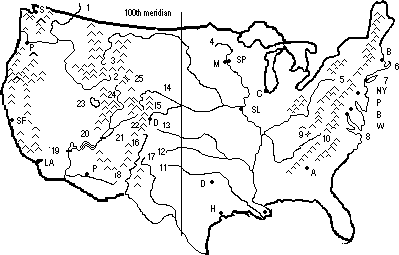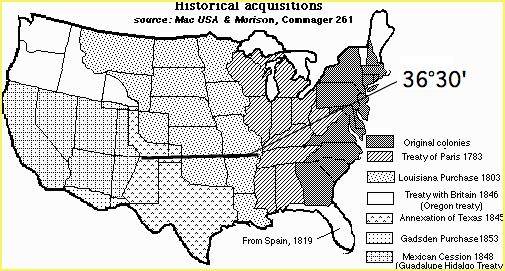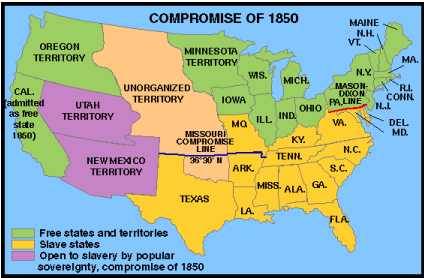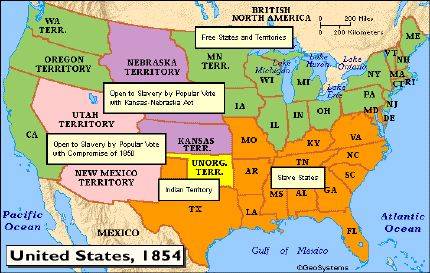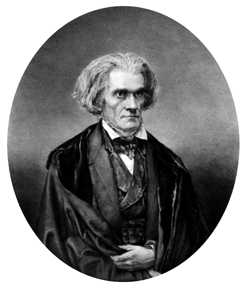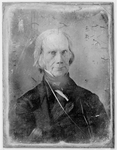http://www.snowcrest.net/siskfarm/nullif.htmlState Nullification "TARIFF OF ABOMINATIONS"
(Sources: Davisdon, Gienapp, Heyrman,
Lytle and Stoff's Nation of Nations, A Narrative History of the
American
Republic, Alfred A. Knopf, c1991; and Alfred H. Kelly & Winfred
A. Harbison, The American Constitution, Its Origins and Development,
Fourth Edition, W.W. Norton & Co., Inc. c1970.)
Congress had raised duties in 1816
and again in 1824. The tariff of 1824 included high duties on
imported
agricultural goods such as hemp, wheat and liquor to protect western
farmers;
imported textiles to protect New England interests; and iron to
protect mining and forging industries of Pennsylvania. South
Carolina
had been particularly hard hit by the depression of 1819. The tariffs
increased
the prices of their imported goods by as much as 50 percent. South
Carolina
asserted that the tariffs were unfair as a tax on Southern agriculture
for the benefit of Northern industry.
When Congress raised the duties
even higher in 1828 with the so-called "Tariff of
Abominations,"
South Carolina's Legislature published the "South Carolina Exposition
and
Protest," or South Carolina Doctrine, protesting the tariff
as unconstitutional and advancing thetheory
of nullification. The Exposition declared that a
sovereign
State had the right to determine through a convention whether an act of
Congress was unconstitutional and whether it constituted such a
dangerous
violation "as to justify the interposition of the State to protect its
rights." If so, the convention would then decide in what manner the act
ought to be declared null and void within the limits of the State,
and the declaration would be obligatory on her own citizens, as well as
the national government.
U.S. Vice President John C. Calhoun
was the (secret) author of the nullification theory. The Union,
he argued, was a compact or league between sovereign States.
Sovereignty
by its very nature was indivisible and absolute. Ultimate
sovereignty
could not be inherent in both the federal and State governments. The
American colonies had always existed as distinct political communities,
which became free, independent and sovereign states at the revolution. The
Articles of Confederation had recognized that separate sovereignty.
The Constitution of the United States had also been drafted by
delegates
acting and voting as states and the compact had been ratified by
the
separate states, each acting as a sovereign entity. Although the
various States
had delegated a portion of their functions to the federal government,
they
had not surrendered their ultimate sovereignty, which was by nature
indivisible. The Constitution was not supreme law, but a
contract
or agreement between sovereign states that set up a federal government
to perform certain functions for the contracting parties. As such,
the
States possessed the final authority to interpret the Constitution. The
central government could not pretend to sovereignty. There was no
such thing as an American nation. The
"people"
were a political fiction, which under central government had come to
mean
the collective popular majority. The numerical majority would
become
tyrannical and disregard the Constitution in order to destroy
minority
rights. The only safeguard for minority rights was State
sovereignty
and nullification.
Nullification was "simply
a declaration on the part of the principal, made in due form, that an
act
of the agent transcending his power is null and void." (The American
Constitution
at 309.) The central government was not a separate sovereignty, but
simply
an agent of the several States. Thus the people of each State,
acting
in special conventions, had the right to nullify federal law that
exceeded
the powers granted to Congress through the Constitution. If a
popular
convention declared a law unconstitutional, it would become null and
void
in a State. Congress could then either yield and repeal the law or
propose
a constitutional amendment expressly giving it the power in question.
If
the amendment was ratified by three-fourths of the States and added to
the Constitution, the nullifying State could then either accept the
decision
or exercise its ultimate right as a sovereign state and secede from
the Union. When Senator Robert Hayne of South Carolina explained
Calhoun's
theory on the floor of the Senate, Senator Daniel Webster of
Massachusetts
replied that the Union was not a compact of sovereign states.
When Congress passed another
tariff in 1832, moderating some of the duties of the prior act but
continuing the protective system, South Carolina's legislature
called
for the election of delegates to a popular convention on November
10
to decide whether the State would nullify the new tariff according to
Calhoun's
formula. The convention overwhelmingly adopted an ordinance of
nullification drawn
by Chacellor William Harper by a vote of 136 to 26. The ordinance
declared
the tariffs of 1828 and 1832 "unauthorized by the Constitution" and
"null,
void, and no law, nor binding upon this State, its officers or its
citizens"
after February 1, 1833. The convention also established legal penalties
for any State or federal officer who attempted to collect the tariff
duties.
It declared that in no case at law or equity in the courts of the State
could the validity of the ordinance or implementing legislation be
questioned
and that no appeal could be taken to the Supreme Court of the United
States.
The legislature further enacted a replevin act authorizing the owner of
imported goods that were seized by customs officials for nonpayment of
duties to recover them (or twice their value) from customs officials.
The
law also authorized the governor to call out the militia to enforce the
laws of the State. The nullifiers declared that any effort of the
federal
government to employ naval or military force to coerce the State, close
its ports, destroy or harass its commerce, or enforce the tariff acts,
would impel the people of South Carolina to secede from the Union
and
organize a separate independent government.
In November 1832, President Andrew
Jackson sent seven small naval vessels and a man-of-war to Charleston
with
orders to be ready for instant action. In December, 1832, he
issued
a "Proclamation On Nullification" to the people of South Carolina
written
by Secretary of State Livingston, stating that the Union was
perpetual,
and under the Constitution, there was no right of secession. The
United States was a nation and not a league and secession was
revolutionary
and would destroy the nation. The power to annual a law of the United
States,
assumed by one State, Jackson stated, was "incompatible with the
existence
of the Union, contradicted expressly by the letter of the Constitution,
unauthorized by its spirit, inconsistent with every principle on which
it was founded, and destructive of the great object for which it was
formed,"
(Robert Kelley's The Shaping of the American Past, Fifth
Edition,
Prentice Hall, c1990, pg 266.) The proclamation ended in a strong plea
and threat:
Those who
told you that you might peaceably prevent [the execution of the laws]
deceived
you; they could not have been deceived themselves... Their object is
disunion.
But be not deceived by names. Disunion by armed force is treason. Are
you
really ready to incur its guilt? If you are, on the heads of the
instigators
of the act be the dreadful consequences; on their heads be the
dishonor,
but on yours may fall the punishment. On your unhappy State will
inevitably
fall all the evils of the conflict you force upon the Government of
your
country... I adjure you ... to retrace your steps. (Source: Essay by
Hal
Morris based mainly on: Robert V. Remini's, The Life of Andrew
Jackson
for The American Revolution.)
Jackson claimed he could have 100,000
men on the side of the Union in a matter of weeks. The South Carolina
legislature
authorized its Governor to call a draft, and appropriated $200,000 for
arms. On the 16th of January [1833] , Jackson requested that
Congress
take steps that would "solemnly proclaim that the Constitution and the
laws are supreme and the Union indissoluble." (The American
Constitution
at 313.) He also sent to Congress the "Force Bill" (often called the
"Bloody Bill"), reaffirming the President's powers to call up
State
militias, the army and navy to quell any insurrection and granted
greater
powers to use the courts to enforce collection of duties. The bill
asserted
the supreme sovereignty of the national government and its right to
enforce
its statutes directly upon individuals by force, if necessary. The
Force
Act passed in the Senate 32-1, with nearly all the nullifiers
having
walked out to avoid casting any vote and in March, the House passed
the Force Act 149-48. On March 1, the Senate passed a Compromise
Tariff.
The nullifiers reassembled their popular convention on March 11 and
repealed
the nullifying ordinance, then proceeded to nullify the Force Act.
(Jackson
chose to ignore the latter.) .
